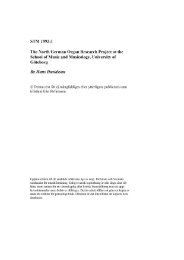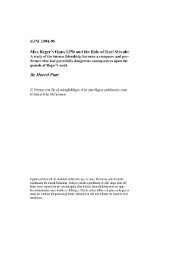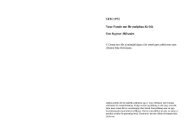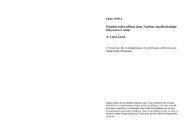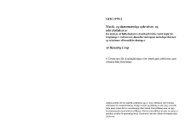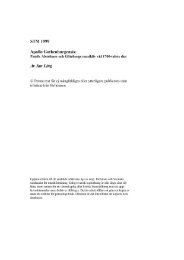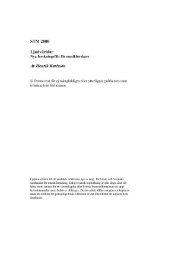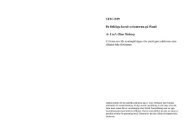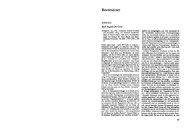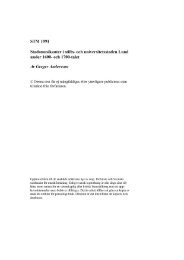Nicolai
Nicolai
Nicolai
You also want an ePaper? Increase the reach of your titles
YUMPU automatically turns print PDFs into web optimized ePapers that Google loves.
ausser der Freude am Aufbau stets noch etwas ganz anderes darin finden: die im<br />
hingegebenen Hören selbst sich vollziehende Erhebung, und zwar echte, seelische<br />
Erhebung, die wir als ein Enthobensein in eine andere Welt, eine solche der<br />
Reinheit und Grösse, empfinden.” (P. 200.)<br />
We experience this ”seelische Erhebung” in an objective form-as belonging<br />
to the music; as having being in the music-and yet as a thrilling in our inmost<br />
being. All designations for this are much too general: “Wir sagen etwa: ’das<br />
Feierliche’ oder ’das Erhabene’, die ’dunkle Tiefe’, das ’Strahlende’, das ’Hin-<br />
reisende’, das ’Aufgeregte’, oder das ’Abgeklärte’ . . . Aber man sieht leicht, das<br />
sind alles nur Bilder, und zwar schwache Bilder. Denn es handelt sich hier nicht<br />
um blasse Anklänge, sondern um mächtige, wahrhaft die Seelen ergreifende Ge-<br />
walt der Musik-eine Gewalt, die mitreisst und die Seele des Hörenden erfüllt, und<br />
dennoch im Tonwerk ihm gegenständlich gegenüber bleibt und die ästhetische<br />
Distanz wahrt.” (Pp. 200-201.) All such characterizations are only feeble de-<br />
scriptions of the mystery of the musical work of art. Indeed, the inner strata are of<br />
primary importance. Here the sounds let the innermost and unutterable life of<br />
the soul appear.<br />
Moreover, music is genuine revelation (Offenbarung)-a revelation which can<br />
be expressed in no other language: ”sie ist Verkundigung und zwar durch Er-<br />
weckung der Seele des Hörenden-zum Mitgehen, Mitschwingen, zu innerster<br />
Lebendigkeit; Anteilgabe am ungreifbaren Empfinden.” (P. 201.)<br />
All works of art require of the viewer an inner act of accomplishment (Mit-<br />
vollziehen). Painting and sculpture require that the viewer ”see” as the artist sees;<br />
poetry requires that the hearer or reader imagine as the poet imagines. In music,<br />
however, the main thing is the ”Erfasstsein” and ”Mitgerissensein”: ”subjectiv ge-<br />
sehen, kann man es so schildern, dass das eigene Seelenleben von der Bewegung<br />
des Tonwerkes ganz aufgenommen und in seinen Bewegungsmodus hineingezogen<br />
wird ... die Musik dringt gleichsam in den Hörer ein und wird im Hören die<br />
seine.” (Pp. 201-202.) Music has an unusual power of uniting people-as<br />
exemplified in the well-known ”phenomenon of the concert hall”. Here the au-<br />
dience as a whole can experience the music, with all individuality dissolved. This<br />
phenomenon is observable especially at concerts of truly great artists. ”Wohl haben<br />
alle Künste etwas von dieser verschmelzenden Macht: sie stellen die Seelen um,<br />
richten sie aus, stimmen sie gleich. Aber keine hat es in dem Masse wie die<br />
Musik.” (P. 201.)<br />
The ego of the listener is dissolved in the music-and yet the music remains<br />
objective. Here lies an antinomy. And how can the inner strata, in which we<br />
feel ourselves enraptured, at the same time remain an object of our observation?<br />
There are two ways of enjoying music. In the one the listener is simply over-<br />
whelmed in the movement of the music. This is what Nietzsche called the ’‘Zer-<br />
fliessen in Tristan-Stimmung”. Such a listener misses the structural fine points.<br />
He makes it easy for himself. In the other way the listener gives attention to the<br />
structure of the musical work and masters the complicated whole. Only the latter<br />
type of listening can be called strictly aesthetical enjoyment: ”Nur sie dringt<br />
wirklich ein-durchläuft die ganze Reihe der Schichten und würdigt die Kompo-<br />
sition.” The first type, however, skips over the structural outer strata, ”wühlt sich<br />
von vornherein in die billigeren Gefühlstöne ein und endet im Selbstgenuss der<br />
eigenen Gefühle, des angeregten Seelenzustandes”. (P. 202.) Thus the aesthetical<br />
relationship is invalidated or very seriously disturbed. Hartmann calls Iisteners<br />
who have this musical ”pseudo attitude” ”Schwelger” (gluttons). On the other<br />
hand, ”Die ästhetisch richtige Einstellung. . . greift nicht, verleitet durch be-<br />
stimmte ’Effekte’, vor, sondern geht Schritt für Schritt mit dem Komponisten,<br />
lässt im inneren Hören den Aufbau des Werkes entstehen und erst an diesem<br />
erscheint ihr das Seelische...” (P. 203).<br />
The antinomy is resolved in this way: the inner strata move the listener and<br />
let him be one with the music in enjoyment; the outer strata are objects of<br />
observation and direct the listener toward an observing attitude.<br />
Hartmann discusses the important and difficult question of how sounds and<br />
sound-sequences let the inner strata appear-or in other words, how music expresses<br />
what is innermost and unutterable in the soul. Tones and sounds arc<br />
indeed something different from human emotions.<br />
Upon closer scrutiny, however, the world of sounds on the one hand and the<br />
world of the emotions on the other are not found to be so heterogeneous as they<br />
seem at first glance. Both are immaterial (unräumlich, undinglich); both are in<br />
flux, transition, and movement. Both develop in stimulation and calming down;<br />
tension and resolution. If there is any medium which can express emotional being,<br />
it should be of the same kind: it ought not to produce in its formations things or<br />
bodies; it should not be a thing-but ”Vollzug”. It must be flowing and in movement<br />
over time, and must be able ro delineate the dynamics of emotional processes.<br />
”Dazu ist in einzigartiger Weise die Welt der Klänge und Klangfolgen befähigt:<br />
in ihr ist alles Bewegung, alles Erregung und Beschwichtigung, ein Wogen und<br />
Schwellen, Abschwellen und zartes Verklingen, leises Raunen und Flüstern oder<br />
dunkles Grollen; wildes Brausen, Stürmen, Entfliehen und Jagen, sowie Bändigung<br />
der entfesselten Gewalten in der musikalischen Form.” (P. 204.)<br />
The arts of the optical sense do not possess these dynamics in the degree that<br />
music does, because they are dependent on the seeing of things. Moreover, ”Zweitens<br />
gibt es in den tonischen Elementen der Musik einen affektiven Gehalt, der<br />
weit stärker ist als der in den Elementen des optischen Sinnes” (p. 204). There<br />
is an emotional element in perception, which is usually repressed in the practical,<br />
everyday life, but which comes to the fore in the aesthetical attitude. And this<br />
emotional element is more prominent in the sense of hearing than in sight. ”Dafür<br />
spricht schon das reich differenzierte Gepräge der menschlichen Stimme, der wir,<br />
ohne es uns klar bewusst zu machen, mit grosser Feinheit charakterliche Züge<br />
der sprechenden Person oder auch ihren augenblicklichen Gemütszustand ’anhören’-und<br />
zwar relativ unabhängig vom Inhalt der Rede.” (P. 204.) Music<br />
intensifies these emotional elements by means of timbre, melody, and harmony.<br />
I will quote in full Hartmann’s enumeration and explanation of the inner<br />
strata (p. 205):<br />
1) diejenige des unmittelbaren Mitschwingens des Hörenden. Sie beginnt schon<br />
im Wiegen der Tanzmusik, ist aber wohl aller Musik eigen. Ihre Wirkung



